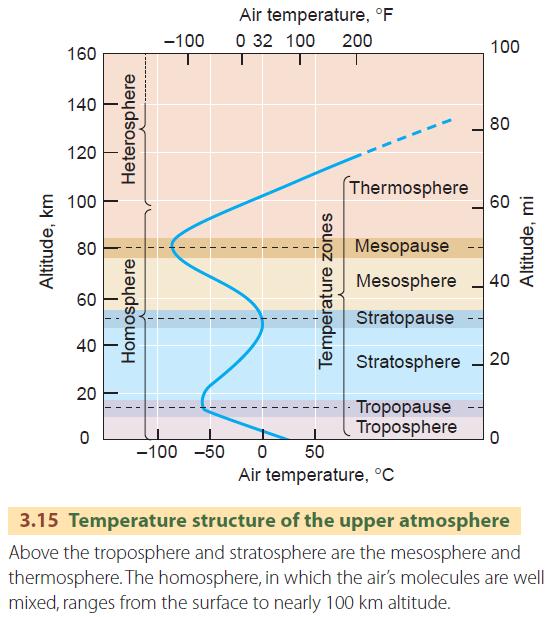Temperature Structure of the Atmosphere
In general, the air is cooler at higher altitudes. Remember from Chapter 2 that most incoming solar radiation passes through the atmosphere and is absorbed by the Earth's surface. The atmosphere is then warmed at the surface by latent and sensible heat flows. So it makes sense that, in general, air farther from the Earth's surface will be cooler.
We call the decrease in air temperature with increasing altitude the lapse rate. We measure the temperature drop in degrees C per 1000 m (or degrees F per 1000 ft). Figure 3.14 shows how temperature varies with altitude on a typical summer day in the midlatitudes. Temperature drops at an average rate of 6.49°C/1000 m (3.56°F/1000 ft). This average value is known as the environmental temperature lapse rate. Looking at the graph, we see that when the air temperature near the surface is a pleasant 21°C (70°F), the air at an altitude of 12 km (40,000 ft) will be a bone-chilling ?55°C (?67°F). Keep in mind that the environmental temperature lapse rate is an average value and that on any given day the observed lapse rate might be quite different.

Figure 3.14 shows another important feature. For the first 12 km (7 mi) or so, temperature falls with increasing elevation. But between 12 and 15 km (7 and 9 mi), the temperature stops decreasing. In fact, above that height, temperature slowly rises with elevation. Atmospheric scientists use this feature to define two different layers in the lower atmosphere—the troposphere and the stratosphere.
TROPOSPHERE
The troposphere is the lowest atmospheric layer. All human activity takes place here. Everyday weather phenomena, such as clouds and storms, mainly happen in the troposphere. Here temperature decreases with increasing elevation. The troposphere is thickest in the equatorial and tropical regions, where it stretches from sea level to about 16 km (10 mi). It thins toward the poles, where it is only about 6 km (4 mi) thick.
The troposphere contains significant amounts of water vapor. When the water vapor content is high, vapor can condense into water droplets, forming low clouds and fog, or the vapor can be deposited as ice crystals, forming high clouds. Rain, snow, hail, or sleet—collectively termed precipitation—are produced when these condensation or deposition processes happen rapidly. Places where water vapor content is high throughout the year have moist climates. In desert regions water vapor is low, so there is little precipitation.
When water vapor absorbs and reradiates heat emitted by the Earth's surface, it helps to create the greenhouse effect—a natural phenomenon that is responsible for warming the Earth to temperatures that allow life to exist.
The troposphere contains countless tiny particles that are so small and light that the slightest movements of the air keep them aloft. These are called aerosols. They are swept into the air from dry desert plains, lakebeds, and beaches, or, as we saw in the chapter opener, they are released by exploding volcanoes. Oceans are also a source of aerosols. Strong winds blowing over the ocean lift droplets of spray into the air. These droplets of spray lose most of their moisture by evaporation, leaving tiny particles of watery salt that are carried high into the air. Forest fires and brushfires also generate particles of soot as smoke. And as meteors vaporize as they hit the atmosphere, they leave behind dust particles in the upper layers of air. Closer to the ground, industrial processes that incompletely burn coal or fuel oil release aerosols into the air as well.
Aerosols are important because water vapor can condense on them to form tiny droplets. When these droplets grow large and occur in high concentration, they are visible as clouds or fog. Aerosol particles scatter sunlight, brightening the whole sky while slightly reducing the intensity of the solar beam.
The troposphere gives way to the stratosphere at the tropopause. Here, temperatures stop decreasing with altitude and start to increase. The altitude of the tropopause varies somewhat with season, so the troposphere is not uniformly thick at any location.
STRATOSPHERE AND UPPER LAYERS
The stratosphere lies above the tropopause. Air in the stratosphere becomes slightly warmer as altitude increases. The stratosphere reaches up to roughly 50 km (about 30 mi) above the Earth's surface. It is the home of strong, persistent winds that blow from west to east. Air doesn't really mix between the troposphere and stratosphere, so the stratosphere normally holds very little water vapor or dust.
The stratosphere contains the ozone layer, which shields Earthly life from intense, harmful ultraviolet energy. It is the ozone molecules that warm the stratosphere, causing temperature to increase with altitude, as they absorb solar energy.
Temperatures stop increasing with altitude at the stratopause. Above the stratopause we find the mesosphere, shown in Figure 3.15. In the mesosphere, temperature falls with elevation. This layer ends at the mesopause, the level at which temperature stops falling with altitude. The next layer is the thermosphere. Here, temperature increases with altitude again, but because the density of air is very thin in this layer, the air holds little heat.

The gas composition of the atmosphere is uniform for about the first 100 km of altitude, which includes the troposphere, stratosphere, mesosphere, and the lower portion of the thermosphere. We call this region the homosphere. Above 100 km, gas molecules tend to be sorted into layers by molecular weight and electric charge. This region is called the heterosphere.